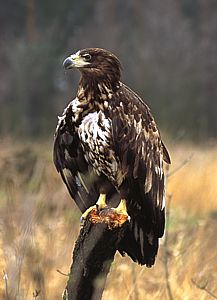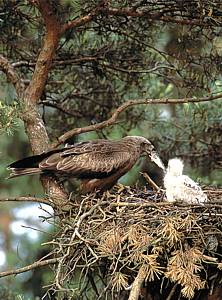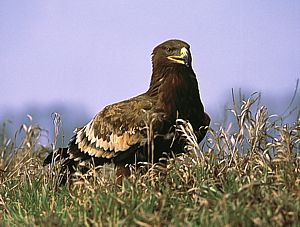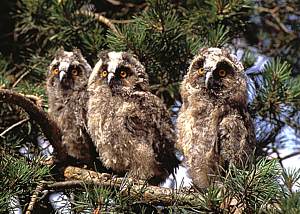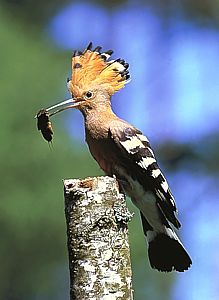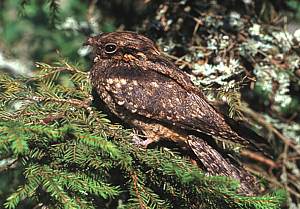|
BIRDS
|
|||||||||||||||
Text:
|
Protected species
The protection of specific animals in Poland regulates the Order of the Minister of Environment from 26 September, 2001. Among the vertebral animals of Wigry National Park embraced with the protection the greatest number is determined by birds - 191 species. One of the most interesting and rare are: white-tailed eagle Haliaeetus albicilla, black kite Milvus migrans and lesser spotted eagle Aquila pomarina, belonging to the goshawk-like family Accipitridae, long-eared owl Asio otus belonging to the tawny owl-like family Strigidae and hoopoe - the only representative of hoopoe family Upupidae and European nightjar Caprimulgus europaeus - the representative of nightjar Caprimulgiformes family.
White-tailed eagle Haliaeetus albicilla is the greatest predacious bird of Poland. The length of body is 85-95 cm, the spread of wings is 200-250 cm, the weight of body reaches 4-5 kg. It flies slowly, slowly striking with wings, sometimes it glides. Haliaeetus albicilla builds its nests in the vicinity of extensive old forests and greater water reservoirs. In the area of Wigry National Park one can observe it over the south banks of Wigry lake. Young Haliaeetus albicilla leads a nomadic lifestyle; when at the age of 5-6 they unite in pairs and build the nests. The nest (of a very solid and reliable construction) is built from a fat branches on the top of old high trees. The bottom of the nest is stuffed with tiny twigs, grass and down. One pair uses several nests, dwelling in a different one every year. In April female lays 2-3 eggs, young birds leave the nest after 10 weeks. Haliaeetus albicilla mostly eats water birds (ducks and geese), hares, young roe-deers, foxes, fishes and carrion.
Black kite Milvus migrans lives in the moist forests, the valleys of greater rivers and the regions abounding in lakes. The length of body is 55-63 cm, the spread of wings is about 140 cm, the weight of body can reach 800-900 g. It flies slowly and it does not fly very high, it often revolves and sometimes hangs in one place. As far as its close relative is concerned, the rust-colored kite has got a longer tail which is more strongly narrow in the waist. It lives in the regions between forests and open areas, in the vicinity of water reservoirs. It sometimes settles in the vicinity of human settlements. The hatching period is in April. It builds the nests in the vicinity of the colony of breeding cormorants and herons, whose nests are often plundered of eggs and the young by Milvus migrans. It eats tiny vertebrates and carrion. The nest are built high on the trees from the branches, dry grass, rootlets, shavings and hairs. The female lays 2-3 eggs; it takes 4 weeks to give birth to the young. When the breeding season is over it lives alone by one or in the loose groups. Milvus migrans belongs to the wandering species; it flies in March and flies away in October.
Lesser spotted eagle Aquila pomarina lives in the areas abounding in forests, swamps and lakes. The length of body is about 65 cm, the spread of wings is about 160 cm, the weight may vary from 1, 2 to 1, 6 kg. The female is a bit larger than the male. It is on the lookout on the trees or other eminences of ground, it moves on the ground in a skillful manner. It flies slowly and often revolves. It lives in the forests, especially wet, when the breeding season is over it flies in the open areas. It mostly eats amphibians, reptiles and other small terrestrial vertebrates. The nest is often built on the leafy trees next to the trunk. Once a year in May the female lays often 2 eggs; the male helps to incubate the eggs. When the breeding season is over, Aquila pomarina lives solitarily. Aquila pomarina belongs to the wandering species; it flies to us in April and flies away in September - October. It spends the winter period in Africa.
Long-eared owl Asio otus lives on the edges of old forests, in the field forestation and parks where the coniferous trees grow. The length of body is about 35 cm, the spread of wings is about 100 cm, the weight reaches 290 g. The male is a bit smaller than the female. What is characteristic to this species are "ears" which make clusters of feathers of about 3 cm long, protruding on the top of the head. Active at night, it flies comparatively slowly, interlacing the active flight with the phases of sliding flight. During a day it has a rest while sitting high on a tree. It lives in small forests, parks, cemeteries etc. The main component of food is field-vole (up to 90% of food), the rest is combined of other rodents and sparrows. The nests are built in old coniferous trees, using the nests erected by other birds. Depending on the alimentary environment it lays 4-6 eggs once or twice a year, which then are incubated by it. Asio otus is a resident species, however in the northern part of its acreage it becomes a wandering species. In the winter period - individuals from Northern grounds fly to Poland and spend the winter together with our owls.
Hoopoe Upupa epops lives on the edges of old leafy stands and avenues lying in the vicinity of meadows and fields. It is about 30 cm long, the spread of wings is 46 cm, the weight varies from 50 to 80 g. Both female as well as male of hoopoe possess a characteristic crest on the head which in the moments of excitement is spread like a fan. The hoopoe eats mainly small invertebrates (mostly insects and worms) which are gathered from the ground. The nests are built in the hollows of old trees, in crevices of buildings and walls of enclosures, under the roots of trees. Hoopoe starts the breeding season in the first half of May - at this time the female lays 4-9 of eggs which are incubated by parents alternately. After about 2 weeks the young nestlings covered with delicate white down are hatched. Uneasy young hoopoes defend themselves by shooting the fetid bronze - liquid produced in the rump gland in the direction of an intruder. Having abandoned the nest the family of hoopoes keeps together for some time flying to the nearby pastures and meadows. Hoopoe is a wandering species; it flies to us in April and flies away in September. It spends the winter period in central Africa.
European nightjar Caprimulgus europaeus is the only representative of the family in Poland. It is 28 cm long, the spread of wings is 55 cm, and it weighs 58-84 g. Judging by the body construction it reminds of a common swift, judging by the flight it reminds of a little falcon and as far as plumage is concerned it looks like an owl. It lives in the dry thinned out pine forests with the fleece formed from grasses and heathers. It is a night bird. It spends the day hidden on the ground or on an upset trunk thanks to the masking feathers which merge with the background. Caprimulgus europaeus hunts for moths and large cockchafers while flying by opening widely its mouth equipped with long stubbles. The breeding season starts twice a year: in May and in July. The female lays 2 eggs directly to the ground, moss or in the vicinity of shrubs. The eggs are incubated by both parents and in case of a danger the eggs are transferred in a beak to some other safe place. It flies to us at the end of April or at the beginning of May and it flies away at the end of August or at the beginning of September. It spends the winter in central Africa.
|
||||||||||||||
|
|
|
